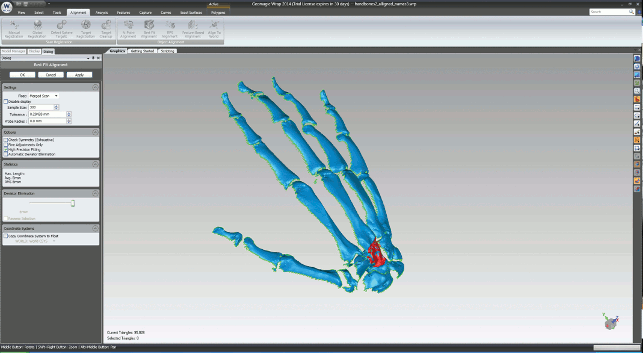Our hands are vital. We use them constantly for all manner of tasks. Now, imagine losing the mobility in one of your hands. It’s almost unimaginable.

The complete hand skeleton was scanned using the Solutionix integrated hardware and software 3D scanning solution – Rexscan CS+
Well, this is what stroke victims experience, and while bionic aids do exist and provide a degree of hand mobility, they are inflexible, cumbersome, not to mention unattractive.
However, Dr. Kazem Alemzadeh and his team from the Robotics Research Group in the Department of Mechanical Engineering at the University of Bristol, UK, have been developing a new intelligent, natural looking glove called ‘Intro-Gluv’.
The key to their work is using advanced 3D scanning technology, which enables them to create an accurate 3D geometric digital model of the skeleton of a human hand that is clinically correct, with each individual bone identified according to accepted hand surgery standards and procedures.
Glove vs exoskeleton
Worn just like a normal glove, Intro-Gluv incorporates sensors, actuators and artificial tendons etc. into different layers of a silicon glove.
Both the palmar and dorsal muscles of the hand are used, providing greater flexibility and a natural movement.
The first step in the project was to acquire an accurate 3D digital model of the skeleton of a human hand. However, not being able to locate any digital models of the hand, they had to develop their own by scanning a physical model.
“We have produced what we believe to be the first clinically correct, fully annotated and deconstructable digital model of the human hand’s skeleton. Without today’s advanced 3D scanning hardware and software technologies we wouldn’t have been able to do this,” says Dr. Alemzadeh.
To help the team carry out the scanning and digital model creation, he turned to Bristolbased 3D scanning technology specialists, 3D Scan Alliance, which used a Solutionix Rexcan CS+ system for the task.
The Rexcan CS+ provides a complete, integrated hardware and software 3D scanning solution that can sit on a desk.
Solutionix’ Blue LED Technology provided high resolution and high accuracy structured light scanning. The scanner also comes with a dedicated, portable stand, a fully integrated and automated two-axis tilt turntable for the object to be scanned and Solutionix’ ezScan software for data capture and processing.
To start, the complete hand skeleton was scanned on both the top and bottom surfaces with the scanner fitted with a 400mm field-ofview (FOV) dual lens-set in order to provide a reference scan of the hand with all bones attached. This set-up provided a scanning resolution (point spacing) of 0.23mm, with better than 30 micron accuracy.
Next, the skeleton was separated into its individual bones. These were then scanned individually, or in groups for the smaller bones, using the same coordinate system as the first scans but this time with the scanner fitted with a 100mm FOV dual lens-set.
This enabled the fine detail of the individual bones and the joint interfaces to be captured to a resolution of 0.05mm with better than 10-15 microns accuracy.

Solutionix Rexscan CS+
The whole process was completed in about two hours. This included converting the raw scan data, on the fly as it was captured, to a polygon mesh using Solutionix’ ezScan software and merging the individual mesh models together.
Comprising nearly 100 million polygons, the resultant mesh model was extremely high resolution but too big for most postprocessing software to handle efficiently.
So curvature-based sampling of the data was performed with the ezScan software to reduce the polygon count in areas of low curvature while retaining it in high curvature areas. This reduced the polygon count to approximately one million (50 MB file size) while retaining all the extremely fine detail.
Physical prototype stage
The next step in the creation of the Intro-Gluv is to create a physical prototype but as Dr. Alemzadeh states, “Without the ability to create an accurate 3D digital model of the skeleton of a human hand in the first place using the Solutionix Rexcan CS+, we wouldn’t have even been able to start on this project, let alone get to the physical prototype stage.”
We expect to reach that stage within the next 18 months to two years. I was amazed at the speed at which the scanning process was completed and the accuracy and detail of the final digital model that was produced,” concludes Dr. Alzemzadeh.
Solutionix 3D scanning technology enables bionic glove development for stroke victims
Default






